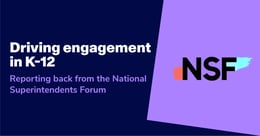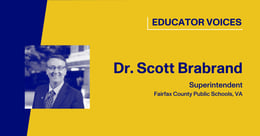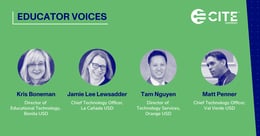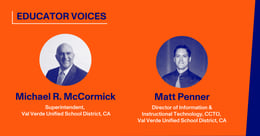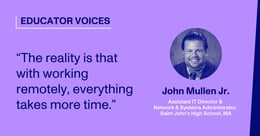
How Spokane Public Schools Serves Their Community: Trauma-Informed Decisions With an Emphasis on Grassroots Participation
Spokane Public Schools is the third-largest district in the state of Washington, with about 32,000 students across 54 schools.
Around one month into distance learning, the Spokane School District leadership team has had to make innumerable considerations during the cataclysmic shift of moving an entire student body and teaching force from one mode of educational services to another.
In his current role as associate superintendent for teaching and learning, Dr. Swinyard oversees all aspects of the district’s educational support services as well as all of its technology services. In this interview, edited for length and clarity, we heard from Dr. Swinyard how his team is basing their decisions on trauma-informed practices, and placing an emphasis on engaging with community leaders to gauge how to best serve the needs of their students and families.
It’s been over a month since school closures. How has the experience been, of making this huge and unprecedented shift, that’s been fraught with so many challenges?
There have been lots of layers to work through. First and foremost, we’re making sure we’re thinking about the wellness of our kids and our families, knowing that this situation has caused significant trauma and stress for them. This has manifested in different ways: Students not being with their teachers, that in many cases are one of the most caring and loving adults in their lives, and missing that sense of connection and community in their life. It’s also stemming from food insecurities, housing insecurities, all the different things that are coming alongside this crisis that we know are making it really hard for our families. That is our primary focus, and we're making our decisions and we're thinking through our next steps through that lens, and really thinking through an equity lens to make sure that we’re not making broad brush stroke decisions and not making assumptions around what's going to be best for a family but really thinking as best we can about considering all those different individual factors and making sure we have interventions and supports in place.
And then just the cataclysmic shift of moving an entire teaching force from one mode of educational services to something that is different. One of the analogies that I've used with our local media and our families is:
It's kind of like going from driving a car to driving a boat. A lot of the same concepts still apply, but it's different and it takes a different skill-set and it takes time to adjust to, to do that well.
And we’ve got incredible teachers that are working very hard but it's definitely a shift, and we know that it will take time for them to really hone their strategies and really figure out what are the best ways to maximize engagement with kids, as well as provide instruction in a way that is aligned with 21st century best practices of virtual learning.
What would you say is the biggest challenge that you’re facing right now?
I think engagement is the number one challenge.
It’s getting kids to participate on a regular basis and really engage with the learning that the teachers are trying to facilitate. I believe that our teachers are going to make this shift and figure out what are the best ways to get kids to participate. Particularly kids that might not historically ever been students that would consider themselves either interested or a good fit for virtual learning and distance environment.
So we're spending a lot of time talking with our teachers about, ‘How do you continue to make that personal connection?’, we know that there's a lot of good of research on virtual learning about the correlation between that personal connection or personal invitation from a teacher and how that increases the likelihood that the students are gonna show up for a live virtual meeting or engage in an online discussion or a collaborative assignment. It’s when they really feel like they've been engaged with on a personal level. So I think that's definitely at the top of our mind.
We know what our data is showing us is that we've got some gaps amongst our community and some disproportionality amongst our families of color and students of color and how they’re engaging, and we want to be really mindful of how we’re reaching out to those communities.
“We're definitely concerned about serving our ELL population as that is one of our student groups that we're seeing some of the lowest level of engagement around."
We know that the language barrier and the school-to-family connections, that have historically been a challenge, are even more so during this crisis. So we’re really trying to reach out to community leaders in those neighborhoods and talk with them about what the families’ challenges are, and what the steps are to support their needs.
We’re making sure that we're trying to be thoughtful around that and not make assumptions around what we think the supports are. We’re really asking leaders, whether that is social service leaders, faith-based leaders, or community center leaders, to participate with us in the messaging as well as message independently.
“We are trying to do it together because we know we want to engage them where we think there is the most relational capital that exists.”
What are the main considerations for going into next year, with respect to the students? What are the discussions your team is having to help the students who might have fallen behind in school new school year?
The first consideration that comes to mind is the toxic stress that this situation is wreaking on our kids. And we know what that does to kids’ development, both neurologically and socially. We know that that is going to have long-lasting effects.
Secondly, it’s the disruption to the pattern that kids are accustomed to, in terms of their daily routines and their school year. They're used to going away for the summer and then coming back in the fall, and that already can be a hard transition back, for teachers to build routines again and their connections and relationships. But now, we’re talking about having been away from them indefinitely, since the middle of March.
I'm really concerned about how hard that transition is going to be for students when they come back. We're going to have to invest a substantial amount of time when we come back on building connections and building up their comfort with the school environment again, as well as building those academic habits and behaviors back up.
I think that challenge is going to be significant. And there's going to be a lot of pressure to jump right into academics and because of the learning regression that we know is going to happen. I'm sure you are seeing some of the initial projections, how in math it can be a half to a whole year of regression, and in reading it can be anywhere from three to four months of regression.
So there's going to be a lot of pressure to put in and really try to recover that learning time, but if we're not as thoughtful as possible about the social-emotional learning aspect of the transition, then we’re going to struggle.
We can definitely see the public pressure of getting that learning back on track immediately. But as you said, making sure that students feel comfortable again in the learning environment is going to set them up for long-term success.
I’m also very concerned about how it’s going to widen equity gaps. Our kids that are well-adapted are going to struggle to make the transition too, but our students that are coming from high-stress, high-trauma environments are going to struggle even more with that pivot back to learning.
Those gaps are going to be aggravated because we're going to have our well-adjusted kids ready to move forward and learn, but it could take longer for the students that are coming from more stressful environments.
What are some of the support systems that you are finding that your teachers are asking for, in terms of running their classrooms online efficiently?
There's kind of two different tiers to that.
One tier is teacher support around facilitating distance learning. In Spokane, we’ve centralized that in our district. We have a learning plan that we’ve developed with a team of teacher experts and curriculum coordinators for each grade level each week. So it’s allowed teachers to focus on facilitating the learning with the tools, rather than both having to plan and to facilitate learning simultaneously. It also just kind of helps our teachers focus their time on the well-being of students and not spend hours trying to make sure that links work or if they’ve recorded videos in the right way. So strategies like those are something we're getting a lot of positive feedback for.
Another tier is making sure that professional development and supports are available in realtime. We’ve had virtual drop-in sessions available for teachers, and chat lines and channels going on in Microsoft teams pretty much all day every day. Because you don't know when teachers are getting engaged in their work, and you don't know when they’re going to have questions. You don't know if it's going to be at 6 AM before their kids wake up or if it's going to be later at 10 PM. So we’ve really tried to make it so they can always get connected to a real person to ask their questions or problem-solve something.
Are there any special shoutouts that you'd like to give out? Maybe somebody that's stepped over and beyond in your team.
Yes. One of our leads for educational technology, Betsy Weigle. In those initial moments we had people that are literally working non-stop, 7 days a week, to get things in place for teachers and students. She's definitely someone who has been a difference-maker for us.
“Whenever you go into something like this, you hope that you have people like Betsy. who have the technical expertise as well as the leadership capabilities, and then also the heart.”


